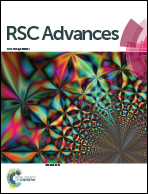Highly monodisperse magnetite/carbon composite microspheres with a mesoporous structure as high-performance lithium-ion battery anodes†
Abstract
In this study, we propose a fabrication method for highly monodisperse magnetite/carbon (Fe3O4/C) composite microspheres with a mesoporous structure. Highly monodisperse porous polystyrene (PS) microspheres are synthesized by traditional seeded polymerization. Textural properties of porous PS microspheres can be controlled by using different amounts of diluent. In order to carbonize and introduce ferrous (Fe2+) and ferric (Fe3+) ions into the pores of PS microspheres, the sulfonation reaction is carried out using sulfuric acid. Fe3O4 nanocrystals are formed in the pores as well as on the surface of the sulfonated porous PS microspheres by a simple wet chemical method. The obtained mesoporous structure of the Fe3O4/C composite microspheres is still retained after a heat treatment in a nitrogen atmosphere. The homogeneous distribution of Fe3O4 nanocrystals in the porous carbon matrix was analyzed through elemental mapping by preparing cross-sections using focused ion beam scanning electron microscopy milling. When the composite electrodes are tested as an anode material in a Li-ion half-cell, the mesoporous Fe3O4/C composite microspheres exhibit not only a high reversible capacity of 562 mA h g−1 after 100 cycles at 1 C but also good capacity retention at various current rates (0.1–10 C) with a high coulombic efficiency of above 99%.


 Please wait while we load your content...
Please wait while we load your content...